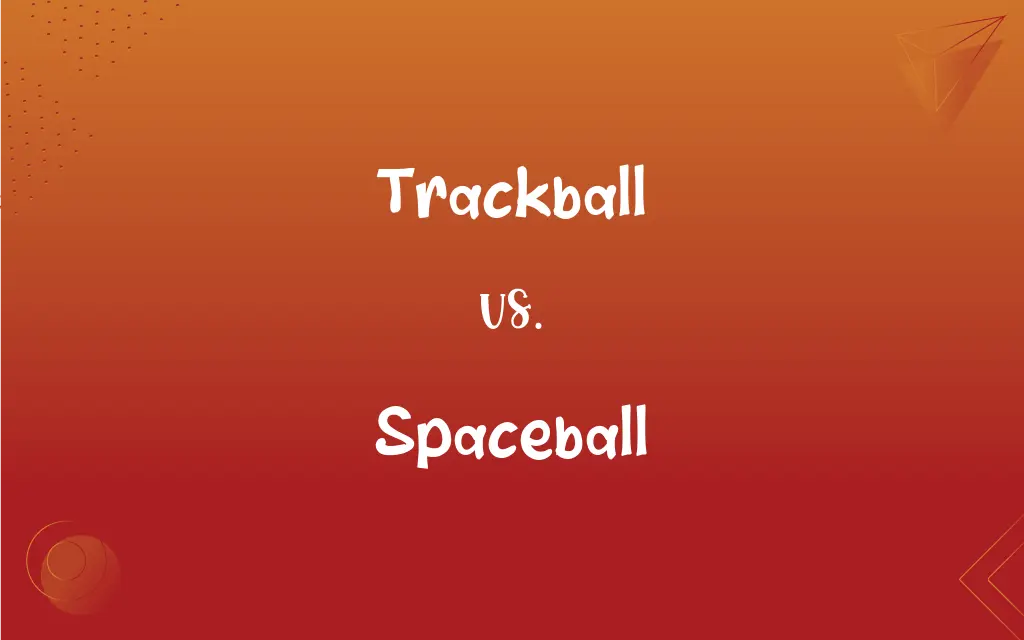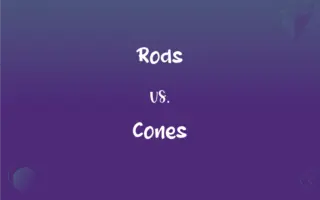Trackball vs. Spaceball: What's the Difference?
Edited by Janet White || By Harlon Moss || Updated on July 11, 2024
A trackball is a pointing device with a ball on top, while a spaceball is a 3D input device for CAD and 3D modeling.

Key Differences
A trackball is essentially an inverted mouse, featuring a ball exposed on the top or side. The spaceball, on the other hand, is a specialized input device primarily used for 3D modeling and CAD applications.
Trackballs are designed to move a cursor on a 2D plane, similar to a regular mouse. Spaceballs allow users to navigate and manipulate 3D spaces, making them ideal for design and engineering tasks.
A user interacts with a trackball by rolling the exposed ball with their fingers or palm. A spaceball is operated by applying pressure or tilting it in different directions to achieve desired 3D movements.
While trackballs are common in various sectors like gaming, graphic design, or general computing, spaceballs are niche and typically found in professional environments. Their unique ability to interpret pressure and direction makes spaceballs perfect for precise 3D tasks.
In conclusion, while both trackball and spaceball serve as input devices, their design and purposes differ considerably: trackballs for general 2D cursor movement and spaceballs for intricate 3D modeling and navigation.
ADVERTISEMENT
Comparison Chart
Primary Use
General computing and 2D navigation
3D modeling, CAD, and design tasks
Interaction
Rolling the exposed ball with fingers
Applying pressure or tilting in desired directions
Dimensional Focus
2D plane
3D space
Common Applications
General computing, gaming, graphic design
Professional 3D modeling and CAD environments
Design
Exposed ball on top or side
Sphere-like device with pressure sensitivity
ADVERTISEMENT
Trackball and Spaceball Definitions
Trackball
Trackball is similar to a mouse but remains stationary.
The trackball provided ergonomic comfort during long hours of work.
Spaceball
Spaceball is a 3D input device designed for modeling.
The engineer used a spaceball for intricate aircraft design.
Trackball
Trackball reduces desk space requirement as it stays put.
With limited desk space, she opted for a trackball instead of a mouse.
Spaceball
Spaceball allows navigation in 3D spaces through pressure and tilting.
With the spaceball, she smoothly rotated the 3D model on screen.
Trackball
Trackball is a pointing device with an exposed rolling ball.
She preferred using a trackball over a traditional mouse for graphic design.
Spaceball
Spaceball interprets pressure and direction for precise movements.
Applying gentle pressure on the spaceball, he zoomed into the model's detail.
Trackball
Trackball can be used in diverse applications like gaming.
The arcade game featured a large trackball for enhanced gameplay.
Spaceball
Spaceball is commonly found in professional CAD environments.
The design studio invested in spaceballs to improve their modeling efficiency.
Trackball
Trackball allows 2D navigation by rotating the ball.
By spinning the trackball, he quickly navigated across the large monitor.
Spaceball
Spaceball enhances the experience of 3D design tasks.
To better interact with virtual reality content, they integrated spaceball input.
Trackball
A ball mounted in a stationary housing and rotated to control a pointer on a computer screen.
Trackball
(computing) A pointing device consisting of a ball housed in a socket
Trackball
An electronic device consisting of a rotatable ball in a housing; used to position the cursor and move images on a computer screen;
A trackball is essentially an upside-down mouse
FAQs
What is the main function of a trackball?
A trackball functions as a pointing device for 2D navigation, similar to a mouse.
Where is the spaceball most commonly used?
Spaceballs are primarily used in CAD and 3D modeling environments.
Can a trackball replace a traditional mouse?
Yes, a trackball can replace a mouse for most tasks, and some users prefer it for ergonomic reasons.
Are trackballs and spaceballs compatible with all computers?
While trackballs are broadly compatible, spaceballs might need specific software or drivers, especially for specialized tasks.
Is a spaceball similar to a 3D mouse?
Yes, both are designed for 3D navigation, but they may differ in design and specific functionalities.
Is the spaceball suitable for general computing?
While possible, spaceballs are designed for specific 3D tasks, making them overkill for general computing.
Are trackballs still popular?
While not as common as traditional mice, trackballs have a dedicated user base, especially among professionals and gamers.
Which device, trackball or spaceball, requires more desk space?
Generally, a trackball requires less desk space since it remains stationary, unlike traditional mice.
How do I clean and maintain a trackball or spaceball?
Regularly clean exposed parts and ensure the device is free from dust and debris for smooth operation.
Is the learning curve steep for spaceball users?
It can be for beginners, but with practice, many users find spaceballs intuitive for 3D tasks.
How do spaceballs enhance virtual reality experiences?
Spaceballs can provide precise 3D navigation, making interactions in virtual environments more immersive and accurate.
Can I use both a trackball and spaceball on one computer?
Yes, both devices can be connected, but their functions and applications might differ.
Can a trackball be used for gaming?
Yes, some gamers prefer trackballs for specific game types, and certain arcade games use them.
Why might a designer prefer a spaceball over a traditional mouse?
The spaceball's pressure sensitivity and 3D navigation capabilities can enhance precision and interaction in 3D environments.
Are there wireless versions of trackballs and spaceballs?
While wireless trackballs are common, wireless spaceballs might be rarer due to their niche application.
Do all trackballs have buttons like a mouse?
Most trackballs come with buttons, similar to a mouse, for various functions and commands.
Can a trackball be used left-handed?
Yes, many trackball models are ambidextrous or come in left-handed versions.
How expensive is a spaceball compared to a trackball?
Generally, spaceballs are more expensive due to their specialized nature and advanced functionalities.
How does a spaceball interpret 3D movements?
Through applied pressure and tilting, translating to 3D rotations, zooms, and pans.
Do trackballs help in reducing wrist strain?
Many users find trackballs more ergonomic and helpful in reducing wrist strain.
About Author
Written by
Harlon MossHarlon is a seasoned quality moderator and accomplished content writer for Difference Wiki. An alumnus of the prestigious University of California, he earned his degree in Computer Science. Leveraging his academic background, Harlon brings a meticulous and informed perspective to his work, ensuring content accuracy and excellence.
Edited by
Janet WhiteJanet White has been an esteemed writer and blogger for Difference Wiki. Holding a Master's degree in Science and Medical Journalism from the prestigious Boston University, she has consistently demonstrated her expertise and passion for her field. When she's not immersed in her work, Janet relishes her time exercising, delving into a good book, and cherishing moments with friends and family.
































































